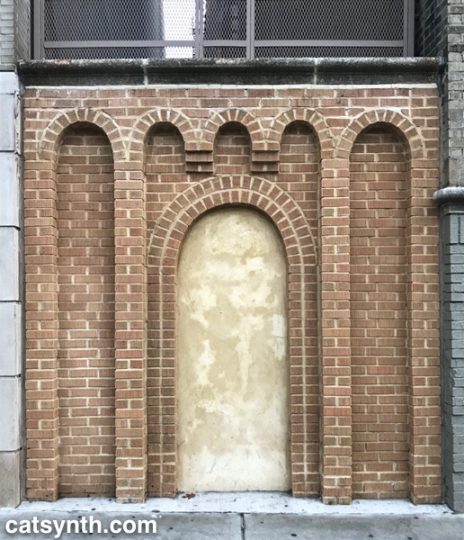
A stylized brick entryway, now sealed and fronting a space between two buildings on the Grand Concourse in the Bronx.
This is an example of a Thomasson.


A stylized brick entryway, now sealed and fronting a space between two buildings on the Grand Concourse in the Bronx.
This is an example of a Thomasson.
The end-of-year colage has become a long-standing tradition here at CatSynth, and one that I particularly enjoy. It was a complex year, and the images reflect that. Our cats Sam Sam and “Big Merp” (who has pretty much become an indoor-outdoor cat at his new home in Oakland), some great shows including outstanding performances with CDP and Vacuum Tree Head, a wonderful and restorative visit back to New York. It was also dark and fiery at times, as when the Camp Fire leveled the town of Paradise and bathed our sky in smoke and ash – beautiful and tragic all at once.
Another New Year tradition at CatSynth is to share some stats from the past year. First, the basics:
Our top posts for the year, using the somewhat shaky measurements of Google Analytics:
It was heartening to see such a diverse set of posts top the list. However, this belies the fact that blog readership is way down, and eclipsed by Facebook and YouTube / CatSynth TV. Most of our referrals to the blog come from these two sources; but most activity stays on Facebook and YouTube. On the plus side, CatSynth TV viewership has grown significantly. Here are the top videos for the year.
Clearly, the NAMM reviews and synth demos dominate the channel, though I am proud of the diversity of art, music, and culture topics shared there as well. Overall, we at CatSynth do see the writing on the wall, and the efforts in 2019 will probably accelerate the shift from blog to video in terms of time, energy and investment.
On a more personal and introspective note, 2018 was a year we accomplished a lot. At the same time, it ends feeling like I both did too much and didn’t do enough. There are still so many things going on, even as we tried to consolidate and focus. One of the challenges going into 2019 will be looking at how to stay organized and even more focused, without giving up on all that we do. Also, like birthdays, a new year is a reminder that time is passing, and we are getting a bit older. Taking care of myself will also be a priority.
Thank you all as always for sharing this past year with us, and wish wish everyone a Happy New Year!
Once again, it’s a perfectly clear day this year. Maybe a little haze, but otherwise a blue sky in San Francisco. But the sounds of the city are a bit sharper today, the foot traffic, the construction equipment, the screeching of the commuter rail and light rails pulling into their stations. And there is a bit of wistfulness, a bit of nostalgia in the most classical sense of the word.
A few things have brought 9-11 back to the fore the anniversary. First, there was the opening of the Cortland Street subway station which serves the 1 IRT line and which was pretty much destroyed in the attack. It’s the last major piece of the puzzle in the rebuilding of the neighborhood, which is a thriving and vital space that includes the transit center, the 9/11 Memorial, and of course 1WTC which has taken its proper place in the skyline.
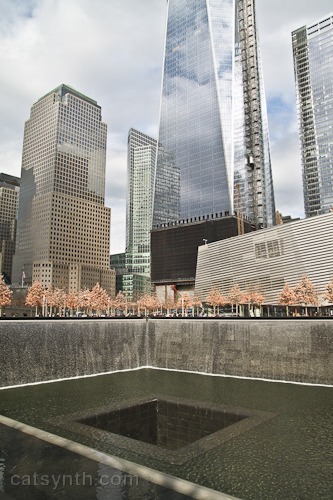
[Photo by CatSynth]
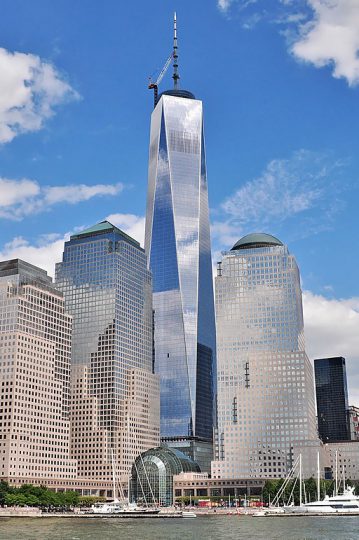
[Joe Mabel (CC BY-SA 2.0 ), via Wikimedia Commons]
Let’s take a moment to emphasize that the building is called 1WTC! It never was, and never will be, the so-called “Freedom Tower”, a name that was obnoxious, jingoistic, and rather gauche. Same thing for the attempts to call the date “Patriot Day”. I always detested that.
The other time bringing today into focus wasn’t 17 years ago, but last year. I was back in New York by coincidence, and the Towers of Light memorial loomed over us in both Manhattan and Brooklyn as we went about simply enjoying being in New York. I posted this picture at the time.
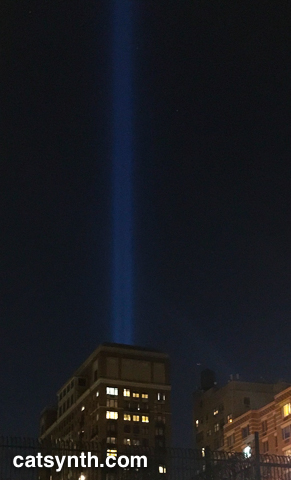
If there is a dominant feeling at the moment, it is more one of homesickness for my home city, the one that will always be The City. And that trip one year ago truly emphasized all its aspect. A wedding on Governors Island with both lower Manhattan and Brooklyn waterfront surrounding us. I rode a record number of subway lines (yes, I’m a total transit nerd). We wandered in Borough Park as well as my usual haunts in Downtown Brooklyn, Chelsea, the West Village, and the Bronx.
17 years ago, the dominant feelings were grief, anger, and (I’m not afraid to admit it) a desire for revenge. That revenge never came – it was twisted by the rest of the country into a nationalistic (and often tacky) morass that turned into multiple wars that left us and the world poorer. The rest of the country rattles its swords, waves its flags, and the great cities suffer. I do hope one day the radical fundamentalism and radical nationalism that grip so many places in the world, including our own country in this moment, will dissipate. And I hope to return home again.
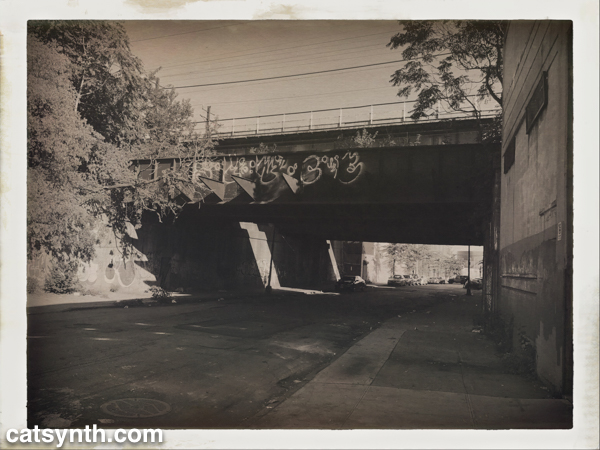
Underneath train tracks in the Point Morris section of the Bronx. You can see a different rendering of the scene in this earlier post.
I make a point of dropping in the Bronx Museum of the Arts when I’m back in New York. This most recent visit did not disappoint, with three strong exhibitions of arts with connections to the borough and New York City at large.

Gordon Matta-Clark: Anarchitect turns familiar notions of architecture upside-down with many projects featuring cuts, holes, and other modifications to derelict and abandoned buildings in New York and beyond. The Bronx of the 1970s was one of his main canvases and the point of departure for his practice. His series featuring the iconic graffiti of the borough’s subway trains and facades leads the exploration, with Matta-Clark observing the built environment as it is.

The next level of his work modifies the built environment by adding his own elements, or rather removing parts of existing architecture. In his Bronx Floor series, Matta-Clark removes a section of the floor of an abandoned building on Boston Road. This serves as a setting for installations and photography.

[Gordon Matta-Clark. Bronx Floor]
Like Matta-Clark, I find these spaces of the Bronx of the 1970s quite inspiring on an aesthetic level. My enjoyment of this often overlooked aesthetic is a bit tempered by the notion that these buildings ended up this way through a variety of bad circumstances: neglect (sometimes deliberate), poor city planning, rising inequality, etc.
From the foment of the South Bronx, Matta-Clark took his concept to Manhattan. In his 1975 project Day’s End, he cut large holes into the abandoned Pier 52 along the Hudson River (I remember the derelict piers that used to line the lower West Side all to well from the 1970s and 1980s).

[Gordon Matta-Clark. Day’s End (Pier 52 in Manhattan)]
This served both as a sculpture and installation in its own right, but also as a performance an exhibition space. Interestingly, the authorities did not notice the initial work cutting out a piece of the building, but they did find out about the performances and happenings, and were none too pleased by this. Eventually, the city dropped charges while he was working on a project in Paris.

[Gordon Matta-Clark. Conical Intersection (Paris)]
Conical Intersect cuts out a section of a partially demolished mansion in the Les Halles district, adjacent to the still-under-construction Centre Georges Pompidou. This was the setting for film and still photography projects, as well as performances and happenings (including “including roasting 750 pounds of beef for passersby on the Pompidou plaza” [
[Susannah Ray. Hutchison River and Co-Op City, 2015.]
Seeing Ray and Matta-Clarks photographs in the same visit shows the evolution of the Bronx, and in particular how the natural spaces have improved since their nadirs in the early 1980s. The lower Bronx River was once a disaster but is returning to new natural-urban balance in recent years.

[Susannah Ray. Canoes, The Bronx River, 2013]
You can read more about the revitalization of the lower Bronx River in this 2016 article. Again, we find beauty in these spaces and admire the work that Ray and others are doing to share it.
The final exhibition takes a decidedly inward turn compared to the explorations of Ray and Matta-Clark. In Elegies, artist Angel Otero explores the long history of painting. His large “deconstructed” paintings bring together traditional practice, abstraction, and collage.

[Angel Otero. The Day We Became People, 2017]
The exhibition is organized in relation to Robert Motherwell’s Elegy to the Spanish Republic series and includes stark black-and-white pieces from Motherwell, sometimes with statements on art and painting.

[Robert Motherwell]
Otero’s work stands apart from Motherwell’s in its vibrant colors and relation to space, as well as its unique use of material. Although titled Elegies, the paintings are not really elegies at all – or at least not in the typical sense. There is an optimism in his work.
The paintings were all created specifically for this Bronx Museum exhibition.
Our visit to the Bronx Museum was also the subject of a recent CatSynth TV episode, which also took us a little further south to visit our friends at the Bronx Brewery in Port Morris.
This fall and winter in New York featured an ambitious citywide art project by Ai Weiwei called Good Fences Make Good Neighbors. Through fences, cages, netting and other forms of “barrier”, Ai Weiwei well-known landmarks as well as quintessentially “New York” locations into expressions of global migration – a complex phenomenon that includes refugee crises around the world as well as the fights for and against immigration in our own country. While the large installations at Washington Square and Central Park perhaps get the most attention, they are also scattered in smaller locations that are part of daily life in the city. We at CatSynth attempted to track down all the major installations and compiled our experiences into this video.
The large sculptural pieces in Washington Square Park and Grand Army Plaza at the corner of Central Park were the most impressive as iconic.

[Grand Army Plaza / Central Park]
The cage at Grand Army Plaza is quite literal, an easily identified barrier between those in the cage and the rest of the city going about its business outside. Of course, one can freely enter and exit this cage at will. The mirrored piece that fills the Washington Square Arch is more abstract, with the silhouettes of human figures forming a welcoming portal in the midst of an imposing fence. This one was the most aesthetically beautiful for me, with its play on reflections and light from the surrounding city.

[Washington Square Arch]
Many smaller installations were scattered around the Lower East Side of Manhattan, a neighborhood long associated with immigration and new arrivals to the United States. Indeed, the European Jewish side of my family settled in this neighborhood in the early 20th century, so it holds particular significance.

[Chrystie Street]
One could be forgiven for overlooking some of these (though the Essex Street Market installation is quite large). In fact, one at East 7th Street was just a narrow fence in the space between two apartment buildings. It took me a couple of minutes to locate it. And business at the boutiques and cafes at ground level went ahead seemingly oblivious.
We also made it to some of the installations in other boroughs, including the one surrounding the Unisphere in Flushing Meadows Corona Park in Queens.


[Unisphere – Flushing Meadows Corona Park, Queens]
The Unisphere is one of the remaining ruins from the 1968 Worlds Fair and with its positive (albeit cynical) message of global and international solidarity, its an apt setting for reflecting on the current migration crises and increasing nationalism worldwide. The borough of Queens has also involved since 1968 to become one of the most diverse places in the world.
And no artistic journey through the would be complete without Brooklyn. Fulton Mall – a section of Fulton Street closed to form a pedestrian mall and bus corridor – was the site of a series of installations adding fencing to some of the bus stops.

[Fulton Mall, Brooklyn]
Downtown Brooklyn has become an important part of my own experience of New York in the past decade, and it seems fitting to end here, where older discount stores and new high-rise condo buildings collide. We will have to see how this ultimately plays out…
We end in the Bronx, where this billboard on the Deegan Expressway may not be part of the official presentation, but it made for a fitting conclusion.

[Deegan Expressway (I-87), The Bronx]
Ai Weiwei: Good Fences Make Good Neighbors will be on display through February 18, 2018. You can read more about the project and its many locations here.